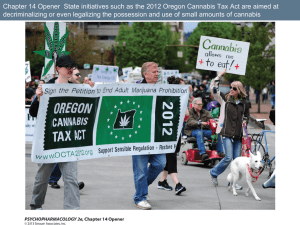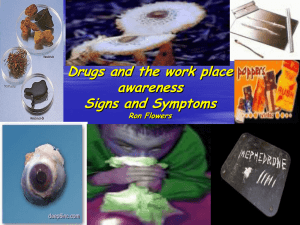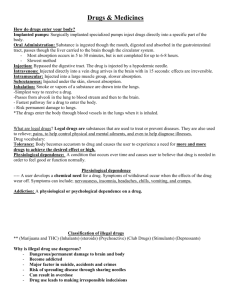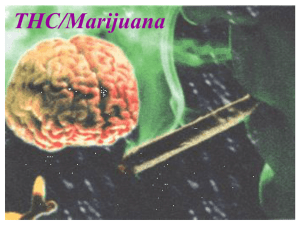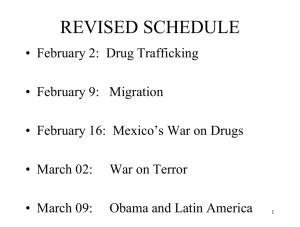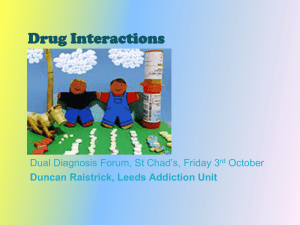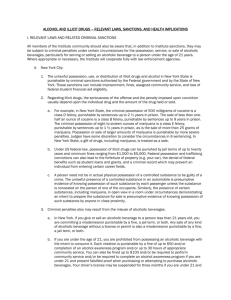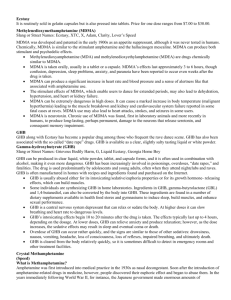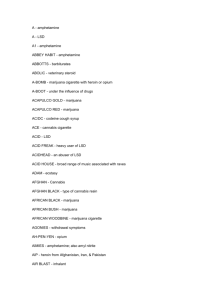Illegal Drugs & Anesthesia
advertisement
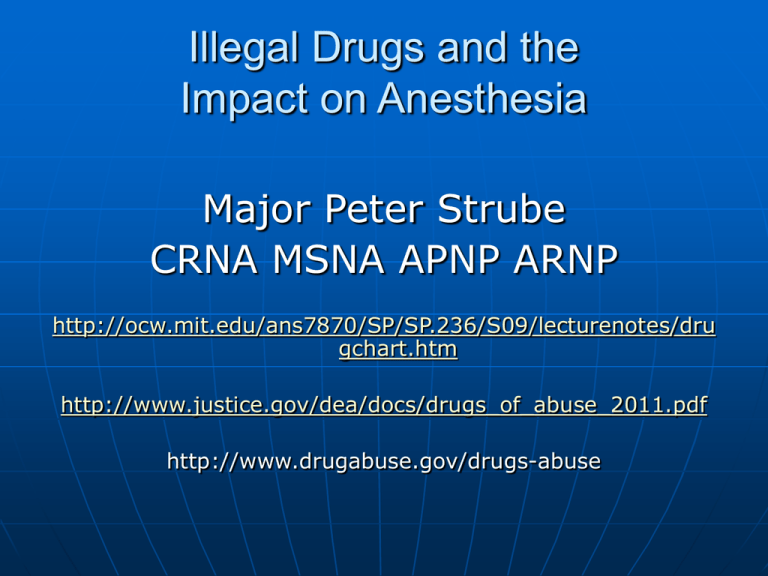
Illegal Drugs and the Impact on Anesthesia Major Peter Strube CRNA MSNA APNP ARNP http://ocw.mit.edu/ans7870/SP/SP.236/S09/lecturenotes/dru gchart.htm http://www.justice.gov/dea/docs/drugs_of_abuse_2011.pdf http://www.drugabuse.gov/drugs-abuse Dedicated to: Thomas G Healey, RN, CRNA, MA St Mary’ s University Died January 5, 2014 Why we do what we do? As Human beings we do whatever we do for a reason We do nothing “just because” We do whatever we do for one or two reasons and two reasons only: Increase Pleasure Decrease Pain Before we Start! Drugs enter the blood stream and head to the brain where they act at certain parts. Dependence: A state in which and organism functions normally in the presence of the drug. (withdrawal) Withdrawal: addicted person looses the additive drug. Caffeine--Antiemetic and Pain control? Central Nervous stimulate Number one consumed psychoactive drug PDE inhibitor Withdrawal headache Via this action a secondary antiemetic; all subjective considering a few studies suggest it does not play a role Awake sleep cycle Increased sensitivity to catacteolamines Spinal HA Caffeine Oral and IV Caffeine; Very effective for temporary relief 75-80% effective in initial treatment, but 48 hour follow up revealed that all patients had a return of their headache Believed to work by blocking adenosine receptors which in turn leads to vasoconstriction of cerebral blood vessels. Methylxanthines derivitive such as, caffeine may also stimulate sodium-potassium pumps to increase CSF production, which can aid in headache relief. Treatment with IV caffeine was not associated with a decrease in the number of patients who required EBP. SE of Methylxanthines deriviative; CNS stimulation, seizures, gastric irritation and cardiac dysrhythmias, limited used with patients with CV disease Methamphetamine Adderall, Crystal Meth, Dexadrine, Crank, Speed, Ice Methamphetamine Adderall, Crystal Meth, Dexadrine, Crank, Speed, Ice Just this easy…http://www.youtube.com/watch?v=wlrLcqvdkac A psycho stimulant Increases alertness, concentration, energy and in high doses, can induce euphoria, enhance self-esteem and increase libido. High potential for abuse and addition. It activates the psychological reward system by triggering a cascading release of dopamine. Approved for treatment of ADHD and Obesity (Desoxyn-5mg) Off Label: Narcolepsy and treatment resistant depression Methamphetamine Neurotoxin to the dopaminergic neurons….long term withdrawal. Japanese study up to a year of psychosis resembling schizophrenia Physical destruction and damage to the cardiovascular system. Routes: Ingestion (62.7%) peaks in 3 hours; IV (100%); Nasal (79%); Inhalation (90.3%); Suppository either rectal or vaginal (99%) Metabolite peaks in 10-24 hours Route of administration also leads to increased risks for anesthesia Metabolism Hepatic Half-Life: 9-12 hours Excretion: Renal Addiction Treatment: Bupropion, aripiprzole, baclofen and Modafinil Effects: Physical: tachycardia; hypertension; hypotension, hyperthermia; convulsions; heart attack, arterial wall vasoconstriction; bronchodilation; hyperglycemia; PE; Pulmonary Hypertension; Psychological: Lots and lots of complications Long Term: Uncontrolled dopamine release, parkinsonism risk and psychological health problems. Natural depletion by massive firing of NE, EPI and Dopamine; 5HT receptors. Meth Mouth;;;;; cardinal sign Shake ‘n Bake New way to make meth….. Materials : 1 box of pseudo-ephedrine pills, 1 Cold-Compress pack, a bottle of lye crystals, 2 AA energizer lithium batteries, Coleman fuel, Iodized salt, sulfuric acid or Muriatic acid, 2 20oz bottles, coffee filters, a clear hose about 6 - 12" long, funnel, 2 Pint Mason jars, and lineman pliers. first off, make sure your working in a clean and safe area. Clean both of the 20oz bottles with some paper towels and a clothes hanger, rinse with Coleman fuel, and repeat. You want the bottles to be clean as possible to make clean dope. After you clean one bottle, use your funnel and one coffee filter and put 8oz of Coleman fuel in the bottle. Then, using your lineman pliers, obtain the lithium metal from the batteries, tear them small balls and put them in your fuel. After you get both your lithium strips in, add 3 tablespoons of crushed Ammonia nitrate from the cold compress pack, and 3 tablespoons of lye crystals. Shake the bottle and get a reaction going. After you get a good reaction add your crushed pseudo-ephedrine and let it cook for 45 minutes to an hour. Burping the bottle when it get tight. refrain from shaking the bottle in the during the last 15 minutes of the cook. Their should be a good amount of copper "b.b.s" floating with your lithium strips. this is a good sign your cook is close to finished. Clean out the mason jar you have ready, and use 3-4 filters to filter off your cook into the mason jar. Now its time to make a smoke bottle, either using sulfuric acid or Muriatic acid. Clean the 20oz bottle like before, and make a hole in the cap big enough for your hose. if your using sulfuric acid, add 1 tablespoon of salt to the bottle and just a couple drops of sulfuric acid. If your using Muriatic acid, put 3-4 balls of aluminum foil in the bottle and a couple drops of Muriatic acid. Put the hose right above your fuel in the mason jar and watch the dope drop. Hit it with the smoke a couple times and stir it up until it doesn't drop anymore, then filter this into another mason jar, and you got your first pull in the filter. dry it out and test it. then take the fuel you poured off and put it back in the cook bottle. cook it for about 30 minutes and try for a second pull. You should yield about a gram, to a gram and a half of Methamphetamine. Heroin Opioid analgesic synthesized from morphine. Used to treat severe pain. Inhalation (44-61%); Tran mucosal; IV (99%); Oral (<35%); Intranasal; Rectal, Vaginal; IM Metabolism; Hepatic Half-life: <10 minutes 90% renal as glucuronides rest biliary Pain Control---Diamorphine, Diacetylmorphine Long Term Effects On The Human Body Neuro-chemical changes in the brain Infection of heart lining and valves Arthritis Bacterial infections Addiction • Compulsive drug seeking and use • Physical dependence • Higher dosage to obtain the same effect Physiological Responses to Heroin - Short Term Heroin changes to Morphine and attaches to opioid receptors within the brain • “Pleasure Center” of the brain • “Dopamine dump” Onset = how much and method of ingestion Dry mouth Heavy extremities Suppression of pain Clouded mental function Warm “Rush” throughout the body Physiological Responses To Heroin Induces a feeling of joy in the Neuro-centers of the brain • You may have physical pain, but you don’t care! •Constricted pupils •Droopy eyelids •Watery eyes •Drowsiness •Loss of Appetite •Sniffles •Cough •Nausea •Lethargy •Lowered heart rate •Lowered Blood Pressure •Slow respiration Opium Grown in • Laos, Myanmar [formally Burma], Thailand (The Golden Triangle) • Afghanistan, Pakistan, Iran (The Golden Crescent) • Colombia, Guatemala, Peru, and Mexico Five Types of Heroin (Horse, Smack, Junk) Black Tar Mexican (Brown) South America a.k.a. Columbian Southeast Asian Southwest Asian “Narcan” Naloxone Hydrochloride Narcan prevents and/or reverses the effects of opiates, especially the respiratory depression Intravenously -reverse effect occurs almost immediately Intramuscularly-slightly longer to take effect Number of narcan doses depends on how much the abuser used Needle exchanges prove free doses of Narcan included w/ new needles Methadone Synthetic Opioid developed in Germany in 1937 Not chemically related to morphine or heroin Cheap and long acting Traditionally used with narcotic abuse Half life 24-36 hours -- fat soluble Mu-receptor with limited action on NMDA 5 -10 mg single dose decreases the intra and post operative opioid requirements This may be a great adjunct to both the chronic pain patient and the short term surgical patient. Additionally this drug does not have the euphoric effects that other narcotics have and this may be of great benefit in those with addictive personalities. Cannabis: THC: Marijuana Cannabis: THC: Marijuana Keif; Hashish; Hash Oil; Residue, Pot, Grass, Weed, Smoke, Dope, Blunt, Reefer, Sinsemilla 162 million users…very popular Psychoactive and physiological effects when consumed Heart rate increased; sensations to hot and cold altered, dryness of the mouth, reddening of the eyes, decrease in intra-ocular pressure, muscle relaxation, change in long term and short term memory issues. Psychoactive; possess all properties, stimulant, depressant, hallucinogen. Increase risk for lung cancer Medical Use: THC: Marijuana Cannabis used medically has several well documented beneficial effects. Treatment of Nausea and Vomiting; hunger by chemo; glaucoma; pain relief ??MS and Depression?? Prescription includes: Marinol and Cesament THC: Marijuana Smoked; orally; tea—low water solubility Works at the CB-1 (Brain) and CB-2 a receptor (Peripheral) Alters mood and cognition through its agonist actions on the CB-1 which inhibit a secondary messenger system of adenylate cyclase. Introducing agonist rimonabant Effects: THC: Marijuana Oxygen consumption can increase by up to 30%. In large doses, orthostatic hypotension and even low blood pressure, syncope, bradycardia, and a drop in body temperature, myocardial infarction, and transitory cerebral ischemia The cardiovascular risk among users increases in the long run because of the carbon monoxide (CO) absorbed with the cannabis smoke. Avoid drugs that increase heart rate. Marijuana smoke contains approximately the same quantity of CO as tobacco smoke, but because of deep and slow inhalation, the concentration of carboxyhemoglobin (COHb) is 5-times higher than with tobacco smoke. HORRIBLE::: RESPIRATORY EFFECTS THC: Marijuana Cannabis can potentiate the hypnotic and sedative effects of substances that depress the CNS such as alcohol, barbiturates, opiates, benzodiazepines, and phenothiazines. As mentioned, cannabis interferes significantly with respiratory function. Problems with ventilation and/or oxygenation under general anesthesia are to be expected and, if possible, local anesthesia is preferable. Smoking cannabis can cause oropharyngitis and uvular edema, leading to airway obstruction under general anesthesia. K-2 Spice K-2 New… synthetic cannabinoid, it provides the same euphoric effect of marijuana Is marketed as “incense” on the internet and in locations where is not illegal Not detectable on urine drug screen Smiles Smile's effects have been called a combination of MDMA and LSD, only far more potent 2003 in Europe, now US Legal until recently Not a lot of information about it yet, just horrible stories and lots of death MDMA—Ecstasy Love Drug, Eve Can induce a sense of intimacy with others, diminished anxiety, fear treatment, pain and PSTD. From Safrole: a black oil extracted from the root of sassafras plants. It releases serotonin, norepinephrine and dopamine. It acts as a agonist of TAAR1. It’s unusual entactogenic effects are related to oxytocin secretion via activation of the serotonin system MDMA--Ecstasy Oral, sublingual, nasal, inhalation, injection, rectal Metabolism: Hepatic, CYP450 (2D6) Half-Life 6-10 hours, usual effects 3-5 hours Excretion Renal Side Effects: MDMA--Ecstasy Hallucinations, delirium; muscle twitching, heat production, hyperreflexia, tachypnea, dyspnea, cardiac arrhythmia, shock, vasculitis, cardiotoxicity, hemorrhage, organ failure, stroke, rhabdomyolysis, DIC. Succinylcholine (X is a trigger) should be used cautiously given the risk of compounding the malignant hyperthermia like effects of the drug, raising intracranial pressure or potentially worsening hyperkalemia Sympathetic stimulation from MDMA intoxication increases myocardial oxygen demand and causes tachycardia, vasoconstriction, hypertension and occasionally acute myocardial infarction and dilated cardiomyopathy if prolonged. Cerebral autoregulation may fail, allowing dangerous increases in cerebral blood flow. Significant hypotension and low cardiac output may be encountered after the initial hyperdynamic state due to catecholamine depletion or autonomic dysregulation. History Cocaine History To Europe, the US August Bier.. 1898 Luer Lock Long History! Cocaine Coke, Crack, Snow, Blow, Crack Stimulate of the central nervous system, an appetite suppressant and topical anesthetic. Specifically, it is a serotonin-norephinephrine-dopamine reuptake inhibitor, which mediates functionality of these neurotransmitters as an exogenous catecholamine transport ligand. Topical (25-43%), Oral (33%), Insufflation (60-80%), Injectable; suppository Metabolism: Hepatic CYP3A4 Half-Life 1 hour Renal excretion Comes in many forms. Traditional Cocaine powder is white. Crack can be yellow or brown in color. Cocaine Why---it doesn’t follow the rule of molecules: It has multiple pockets of high hydrophilic and lipophilic efficiency. This enables it to cross the blood brain barrier with vastly superior reinforcement than other psychoactive chemicals. Increases alertness, feelings of well being and euphoria. It increases energy and motor activity, feelings of competence and sexuality. Acute verse Chronic Use Cocaine A major concern in the clinical anesthetic management of the cocaine abusing patient is the appearance of cardiac arrhythmias, such as ventricular tachycardia, frequent premature ventricular beats or torsades de pointes. Cocaine induced cation channel blockade causes lengthening of the QT interval by prolongation of the action potential. QRS and QT prolongation which is considered to be the primary underlying mechanism for the induction of these cocaine-induced arrhythmias Cocaine Increased blood pressure, Constricted blood vessels, Dilated pupils, Mental alertness, Increased energy, Increased heart rate Decreased appetite, Increased temperature Long Term effects of Cocaine: heart disease, heart attacks, respiratory failure, strokes, seizures, and gastrointestinal problems. Other physical symptoms include convulsions, nausea, blurred vision, chest pain, fever, muscle spasms, and coma. Cocaine 40mg = $59.50—Medical Use The first local anesthetic used medicinally Its sole medical use is as a topical local anesthetic for ENT surgery and sometimes for nasal intubations • Vasoconstriction decreases bleeding • Sensory anesthesia achieved Half-life of 45 minutes In the presence of ETOH, the metabolic pathway is altered to produce cocaethylene, which is more toxic than cocaine Careful! Coronary artery spasm, risk of ischemia or MI. Comes in a 4% liquid solution LSD—Acid Blotter, Microdot LSD—Acid Blotter, Microdot Lyseric acid diethylamide Works on Dopamine and Serotonin receptors. The psychedelic effects are attributed to its strong partial agonist effects at the 5-HT-2A receptor. Exactly how it produces this is still largely unknown. It also works on NMDA receptors. Assumption is that it increases glutamate in the cerebral cortex and therefore excitation of this area. Routes: Oral, IV, Ocular, intramuscular Hepatic Metabolism with renal elimination Half-life: 3-5 hours Not considered addictive. Due to rapid build up of tolerance LSD--Acid LSD can cause pupil dilation, reduced appetite (for some, it increases), and wakefulness Other physical reactions to LSD are highly variable and nonspecific, and some of these reactions may be secondary to the psychological effects of LSD Numbness, weakness, nausea, hypothermia or hyperthermia (decreased or increased body temperature), elevated blood sugar, goose bumps, increase in heart rate, jaw clenching, perspiration, saliva production, mucus production, sleeplessness, hyperreflexia, and tremors LSD Uses Psychotherapy, treatment of alcoholism, end of life anxiety, pain and cluster headaches. Spiritual effects Creativity Complications: lack of impulse control leading to physical injury, seizures, panic and anxiety attacks, psychosis, suggestibility, PTSD, Flashbacks, HPPD—hallucinogen persisting perception disorder. Premature uterine contractions and genetic defects ( mixed results). PCP PCP (Sernyl) Angel Dust, Special K PCP (Angel Dust) is a formally used anesthesia agent. Works on the NMDA receptor and causes dissociative anesthetics. Also works on the D-2 receptor to cause the psychosis effect. PCP also has dopaminergic agonist effects, complex actions on both nicotinic and muscarinic cholinergic systems, N-methyl-D-aspartate (NMDA) antagonist effects, and poorly understood interactions with noradrenergic and serotonergic neurotransmission Smoked, Insufflated, Oral Half-life 7-46 hours. Ketamine… 1/20th the strength of PCP PCP (Sernyl) Brain Damage leading to Olney’s Lesions in the brain from chronic use Schizophrenia, mania, delirium and disorientation Psychological effects include severe changes in body image, loss of ego boundaries, paranoia and depersonalization. Hallucinations, euphoria, suicidal impulses and aggressive behavior Common cardiovascular effects, probably due to both sympathomimetic action and decreased baroreceptor activity, include moderate elevations in heart rate (typically 20–30 beats/min) and blood pressure (typically 10–20 mm Hg, with systolic greater than diastolic), resulting in increased cardiac output. Noncardiovascular sympathomimetic effects include diaphoresis, lacrimation, and increased bronchial and salivary secretions. PCP (Sernyl) PCP causes a variety of serious medical complications, including coma, seizures, hyperthermia, intracranial hemorrhage, apnea, and acute rhabdomyolysis (often resulting in myoglobinuria and acute renal failure) Direct depression of myocardial contractility and decreased peripheral vascular resistance may cause hypotension and circulatory collapse PCP (Sernyl) At low PCP doses (5 mg or less), physical effects include shallow, rapid breathing, increased blood pressure and heart rate, and elevated temperature. Doses of 10 mg or more cause dangerous changes in blood pressure, heart rate, and respiration, often accompanied by nausea, blurred vision, dizziness, and decreased awareness of pain. 4-Methylthiomphetamine Synthesized amphetamine-type drug Very similar to amphetamine and MDMA Street Name—Flat liner Created in the 1990’s as a slimming and anti-depressant a potential replacement for Prozac It causes a rave culture—affects include: euphoria, increased energy and mild hallucinations. IT is 6 times more potent than MDMA at inhibiting 5-HT uptake. 4-Methylthiomphetamine Risks: It can cause massive serotonin release leading to pronounced hyperthermia. This can lead to organ failure and death. During anesthesia: increased nausea, nystagmus, hyperthermia, pressure on the eyeball, thirst, shivering, confusion, memory loss, coma and heart attack. Amnesia can last hours. New drug with limited information to date. Ephedra Contains alkaloids including ephedrine, pseudoephedrine, norephedrine, methylephedrine and norpseudoephedrine. It has been suggested for weight loss, diet, increased metabolism, bronchodilator, asthma and the common cold. It causes a dose dependent increase in blood pressure and heart rate. This is done through a noncatecholamine sympathomimetic agent that shows alpha 1 and alpha 2 and beta effects. FDA banned this product recently—2006—later reversed Risks include: MI, CVA, uncontrolled BP, Increased HR Ephedra Known to cause hypersensitivity myocarditis, tachyphylaxis from long term use that has depleted all catecholamines… This leads perioperative hemodynamic instability,,,,, Uncontrolled hypotension; hypertension (moa) stroke and MI Stop at least 24 hours prior to surgery. 2 weeks is better This drug is trouble…. Removed by FDA ban Half life is 5.2 hours and 80% excreted unchanged in the urine Mix ACE. Aspirin, Caffeine, Ephedra Inhalant Abuse: Volatile substances that produce chemical vapors that can be inhaled to induce a psychoactive or mild altering effect. They act on the central nervous system except for nitrates. Not sure where, but it appears dopamine is the area that this works on in the brain. Broad range of chemicals but the common characteristic is they are rarely if ever taken by any route but inhalation. Volatile: Vapors at room temp Aerosols: sprays that contain a propellant and solvent Gases: we use it all the time. Nitrates: Poppers or snappers. They relax smooth muscle and dilate blood vessels. They alter moods and are sexual enhancers. Inhalant Abuse: Growing group of abused drugs…. Under 18 is the biggest group. Easy to get and easy to use. You can pick it up anywhere Inhalants cause severe damage to the lungs, liver, kidneys, bone marrow and the brain. Can cause suffocation, stroke, loss of consciousness and death Sniffing or snorting Spraying Bagging Huffing Inhaling Gasoline, glue, vegetable spray, hairspray, deodorant spray, paint thinner, transmission fluid, air freshener, Nitrites, Rush, Locker room popper, Whippets, Nitrous Inhalant Abuse: Irregular and rapid heart rate; heart failure Sudden sniffing death Asphyxiation, suffocation, convulsions, seizures, choking Trauma related to use Pulmonary damage and inability to ventilate. Organ failure Aggressive and violent behavior Withdrawal Symptoms: Insomnia, irritability, cramps, nausea, tremors, depression, headache, confusion, convulsions Bath Salts Bath Salts Informal "street name" for a family of designer drugs often containing substituted cathinones, which have effects similar to amphetamine and cocaine. Their crystals often resemble legal bathing products like epsom salts, but are chemically disparate from actual bath salts. Bath salts' packaging often states "not for human consumption" in an attempt to avoid the prohibition of drugs Users of bath salts have reported experiencing symptoms including headache, heart palpitations, nausea, and cold fingers. Hallucinations, paranoia, and panic attacks have also been reported News media have reported associations with violent behavior, heart attack, kidney failure, liver failure, suicide, and an increased tolerance for pain. Visual symptoms similar to those of stimulant overdoses include dilated pupils, involuntary muscle movement, rapid heartbeat and high blood pressure. Many documented users have also had a history of mental illness And… Really Scary! Krokodile…Codeine, Lighter fuel and Gas Oxi….Cocaine, lighter fuel and Gas…Oxi: Twice as powerful as crack cocaine at just a fraction of the price Top Abused Prescription Drugs Ambien Seroquel Dilaudid—Little D, Lords Xanax Desoxyn Phenegran Adderall Laundanum OxyContin Opana I didn’t even talk about the big one… Ethyl Alcohol: • Beer, wine, ale, liquor, Spirits, booze.. • You all know several addicts.. Smoking… Obesity is the new smoking addiction.. Sound crazy… Cigarettes, Smokeless Tobacco, Chew, Dip, Cigs Now introducing to YOU! OTP…. ???? What is OTP? OTP = Other Tobacco Products • • • • Chewing/Spit Tobacco Snus Dissolvables Cigars/Cigarillos Snus Dissolvables Photo source: http://tobaccocommons.com/tag/camel-strips/ Dissolvables: Sticks Dissolvables: Strips Camel Dissolvables: Orbs THE PROBLEM Photo source: FACT collection Point of Purchase Additional thoughts to consider Where do you Live? Khat…. Thank you… Questions….

